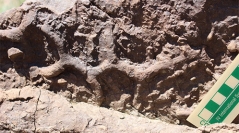

 Comptes Rendus Palevol
22 (27) - Pages 569-583
Comptes Rendus Palevol
22 (27) - Pages 569-583Thalassinoides Ehrenberg, 1944 are relatively common bioturbational structures in carbonate shallow marine successions from the early Paleozoic. Much rarer is the reference to this ichnogenus in siliciclastic formations from the same age. In the Ordovician Lashkerak Formation cropping out at the Central Alborz mountains, Iran, Thalassinoides is a common trace fossil in wave-dominated shoreface complex and prodelta-mouth bar environments of a fluvial-dominated delta. We compare the Middle-to-Upper Ordovician branching networks of the Unit 2 of the Lashkerak Formation with the ichnospecies Thalassinoides horizontalis Myrow, 1995 emphasizing the almost entire bedding-parallel orientation, regular branching and lack of constrictions and swellings. The eodiagenetic halos developed from mucus-lining walls, or by change of the original sediment fabric, typical of this and other ichnospecies of Thalassinoides in carbonate settings are not found in sandstones. The almost polygonal mazes from the Lashkerak Formation are also compared with the recently erected Protopaleodictyon aitkeni Morgan, Henderson & Pratt (2019), considered as a giant graphoglyptid in an early evolutionary stage of these forms in shallow marine environments. Both trace fossils are similar in morphology, size, preservation, ichnofacies and interpreted function, thus being P. aitkeni a junior synonym of Thalassinoides horizontalis.
Thalassinoides, Protopaleodictyon, fluvial-dominated delta, Middle-to-Upper Ordovician, Lashkerak Formation